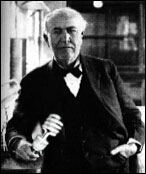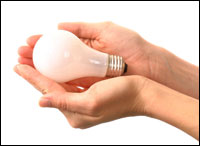Dear Umbra,
I am reluctant to switch to compact fluorescent light bulbs because that means tossing out not only used-but-still-working incandescent bulbs, but also the brand-new bulbs I have waiting in the closet. Is it really a positive effect overall when we’re reducing our carbon emissions but adding to landfills?
Julie
Pittsburgh, Pa.
Dearest Julie,

Damn fine idea … don’t
know why I didn’t think
of it myself.
The gummint says, if every American household replaced five incandescents with higher-efficiency fixtures or bulbs, it would keep a trillion pounds of greenhouse gases out of the air. You tell me: would you rather have a full landfill, or have the Arctic devoid of ice? Climate solutions take precedence over garbage-production concerns, particularly when the garbage is relatively harmless.
I don’t advocate throwing away your old bulbs, and I’ll get to that in a moment, but were you to chuck them I would not shudder. Toxin-containing refuse, on the other hand, must be attended to, natch. Regular readers of Grist know that trash that requires special care includes home electronics, especially computers and cell phones, household chemicals, paints, heavy metals, and — wait for it — compact fluorescents. Doesn’t mean you can’t get these items out of your house, just means don’t throw them in the garbage.

Goodbye, old friend.
Photo: iStockphoto.
Your old bulbs may still have a place in your household. Compact fluorescents, though definitely fab and effective and important, are still a bit more expensive than incandescents. They’re worth the money — around 75 percent more efficient! — but I wonder if you have the cash to replace all your incandescents in one fell swoop. Also, your ordinary, run-of-the-mill CFLs aren’t useful in every light fixture: they can’t be used in enclosed, recessed fixtures (too hot), and only certain types work with dimmer switches and outdoor fixtures. CFLs also aren’t necessarily good for locations where you turn on the light only briefly, such as a coat closet, because they can take a few moments to reach their full brightness.
In sum, do all you can to replace incandescents with CFLs. But you will likely still have some use for your old bulbs. If you don’t think that’s the case, try donating them to a local organization. And if all else fails, you have my permission to gleefully throw them in the garbage. After all, that’s where they’d eventually end up anyway — and a lot sooner than those long-lasting CFLs. (Besides, what’s more satisfying than the sound of breaking glass?)
We should be thoughtful about producing innocent trash, but not think so hard that we stop ourselves from advancing climate solutions.
Lumenly,
Umbra


